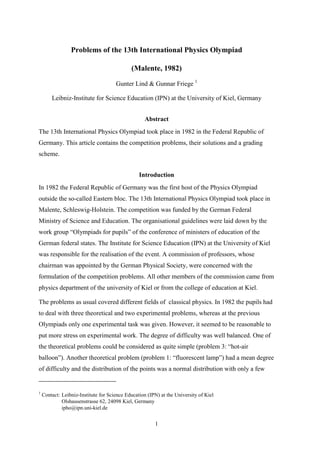The document describes the problems presented at the 13th International Physics Olympiad held in Malente, Germany in 1982. It includes the five problems given to students, which covered both theoretical and experimental classical physics topics. It provides the solutions and explanations to each problem. The problems tested students on topics like electric circuits, oscillatory motion, optics, and spectroscopy. They varied in difficulty, with the oscillating coat hanger problem being the most challenging. The experimental problems required both theoretical understanding and experimental skills to solve.
















![17
That means: the dependence of F from r is approximately linear. F will be zero if
r m g
R 2
⋅
= .
Experimental results:
s = L − (2 ⋅ R⋅D + D2
)
1
2
− (2 ⋅ R⋅d − d2
)
1
2
s = L − 4.5 cm = 39.2 cm − 4.5 cm = 34.7 cm
r
[cm]
t
[s]
t
[s]
a
[m/s2
]
F
[N]
0.75 1.81 1.82 1.82 1.816 0.211 0.266
1.50 1.71 1.72 1.73 1.720 0.235 0.181
2.25 1.63 1.63 1.64 1.633 0.261 0.090
3.00 1.56 1.56 1.57 1.563 0.284 0.004
3.75 1.51 1.51 1.52 1.513 0.304 - 0.066
4.50 1.46 1.46 1.46 1.456 0.328 - 0.154](https://image.slidesharecdn.com/problemandsolutionipho13-131004193330-phpapp01/85/Problem-and-solution-i-ph-o-13-17-320.jpg)


